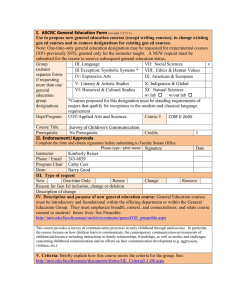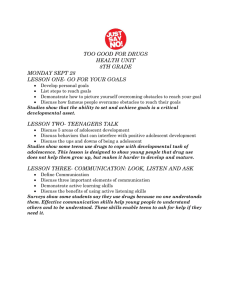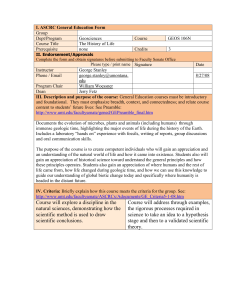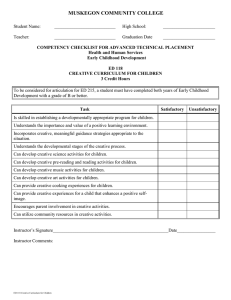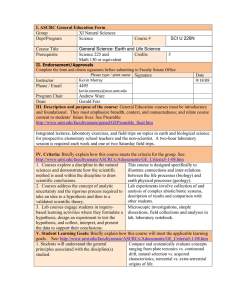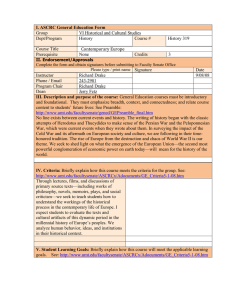I. ASCRC General Education Form Group Social Science Dept/Program
advertisement
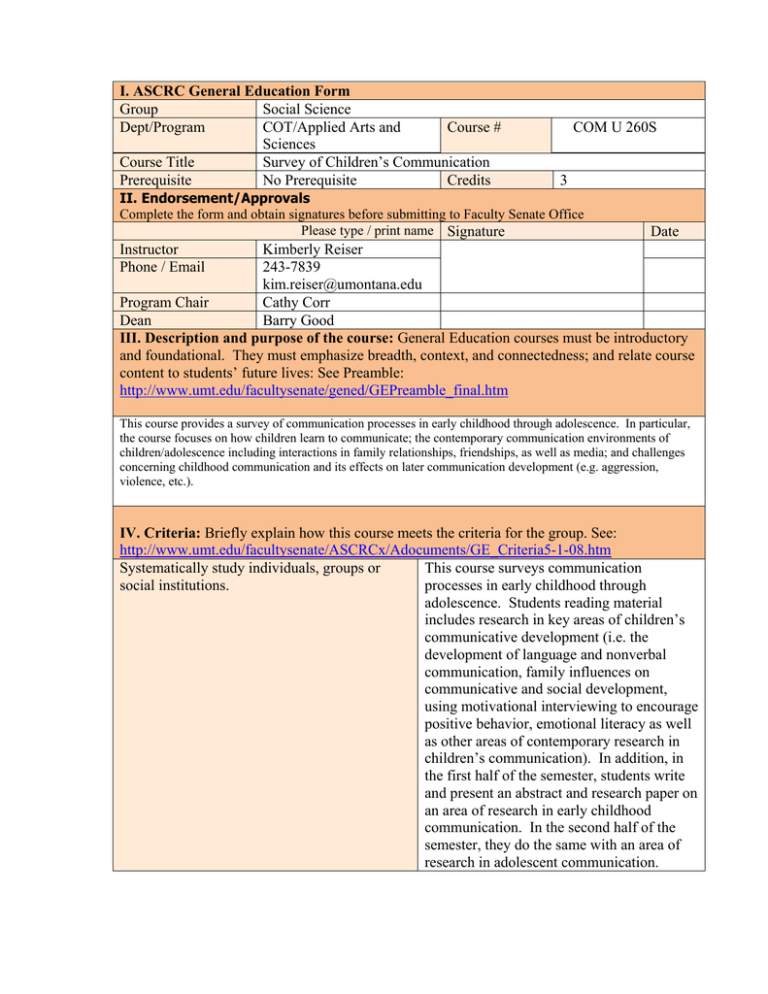
I. ASCRC General Education Form Group Social Science Dept/Program COT/Applied Arts and Course # Sciences Course Title Survey of Children’s Communication Prerequisite No Prerequisite Credits COM U 260S 3 II. Endorsement/Approvals Complete the form and obtain signatures before submitting to Faculty Senate Office Please type / print name Signature Date Kimberly Reiser 243-7839 kim.reiser@umontana.edu Program Chair Cathy Corr Dean Barry Good III. Description and purpose of the course: General Education courses must be introductory and foundational. They must emphasize breadth, context, and connectedness; and relate course content to students’ future lives: See Preamble: http://www.umt.edu/facultysenate/gened/GEPreamble_final.htm Instructor Phone / Email This course provides a survey of communication processes in early childhood through adolescence. In particular, the course focuses on how children learn to communicate; the contemporary communication environments of children/adolescence including interactions in family relationships, friendships, as well as media; and challenges concerning childhood communication and its effects on later communication development (e.g. aggression, violence, etc.). IV. Criteria: Briefly explain how this course meets the criteria for the group. See: http://www.umt.edu/facultysenate/ASCRCx/Adocuments/GE_Criteria5-1-08.htm Systematically study individuals, groups or This course surveys communication social institutions. processes in early childhood through adolescence. Students reading material includes research in key areas of children’s communicative development (i.e. the development of language and nonverbal communication, family influences on communicative and social development, using motivational interviewing to encourage positive behavior, emotional literacy as well as other areas of contemporary research in children’s communication). In addition, in the first half of the semester, students write and present an abstract and research paper on an area of research in early childhood communication. In the second half of the semester, they do the same with an area of research in adolescent communication. Analyze individuals, groups, or social problems and structures; and or This course analyzes the challenges posed by the contemporary communication environments of children, including adolescent bullying, social and emotional challenges for adolescent boys and girls, and media influences. In addition, the course analyzes challenges concerning early childhood communication and its effects on later communication development (e.g. aggression, substance abuse, premature sexuality, and violence). Give considerable attention to ways in which Students review and interpret current research on child and adolescent conclusions and generalizations are developed and justified as well as methods of data communication both through course readings collection and analysis. and their own research projects. V. Student Learning Goals: Briefly explain how this course will meet the applicable learning goals. See: http://www.umt.edu/facultysenate/ASCRCx/Adocuments/GE_Criteria5-1-08.htm Students trace the development of children’s Describe the nature, structure, and historical development of human behavior, organizations, nonverbal and verbal communication. As social phenomena, and/or relationships; mentioned above, they also analyze the contemporary communication environment of children. Use theory in explaining these individuals; Students identify environmental influences group, or social phenomena; and/or on children and adolescents’ communicative and social development. As noted above, students also use the research (theory) in course readings to analyze an area of both early childhood communication and adolescent communication. Furthermore, their ability to use theory to explain children is tested through mid-term and final essay examinations. Students review and interpret current Understand, assess, and evaluate how research on child and adolescent conclusions and generalizations are justified based on data. communication. They do this by leading and engaging in discussion over course readings (research on many contemporary children’s communication issues, as noted above) as well as researching a topic in early childhood communication and adolescent communication independently. VII. Syllabus: Paste syllabus below or attach and send digital copy with form. ⇓ The syllabus should clearly describe how the above criteria are satisfied. For assistance on syllabus preparation see: http://teaching.berkeley.edu/bgd/syllabus.html The University of Montana-Missoula College of Technology Applied Arts and Sciences Department Spring 2008, Course Syllabus Course Number and Title: Com 260S, Survey of Children’s Communication Semester Credits: 3 Instructor: Kim Reiser, M.A. E-mail: Kim.Reiser@mso.umt.edu I am most easily reached by e-mail. However, if e-mail is not easily accessible to you, it is also possible for you to leave messages for me at 243-7839 or the HB faculty office. Office Location: Main faculty office in the HB building Office Hours: Monday and Wednesday 9-10, or By Appointment Course Description This course provides a survey of communication processes in early childhood through adolescence. In particular, the course focuses on how children learn to communicate; the contemporary communication environments of children/adolescence including interactions in family relationships, friendships, as well as media; and challenges concerning childhood communication and its affects on later communication development (e.g. aggression, violence, etc.). Student Performance Outcomes 1. Trace the development of children’s nonverbal and verbal communication. 2. Identify environmental influences on children and adolescents’ communicative and social development. 3. Observe and analyze patterns of children and adolescents’ communication with one another. 4. Review and interpret current research on child and adolescent communication. Textbooks Roberts, M. (2000). Horse sense for people. NY: Penguin Books. Research Articles on Electronic Reserve (www.lib.umt.edu). Grading Exams (2) – 30% of grade One abstract paper on early childhood communication – 10% of grade One abstract paper on adolescent communication – 10% of grade Attendance and Participation (Including Discussion Leadership) – 10% of grade Research Paper #1 Early Childhood Communication – 20% of grade Research Paper #2 Adolescent Communication – 20% of grade Attendance Policy Your attendance and participation will be graded out of 10 points each day; discussion leadership will be graded out of an additional 10 points. Due to the fact that emergencies arise, you will be given one free day. Keep in mind that the class only meets once a week, and due to the discussion nature of this course, attendance plays an important role in the learning of each student in the class. If you are present each day of class, I will add 10 points to your lowest grade in the class. Test Makeup Policy: I believe the classroom setting should be treated like any other professional setting. Employers and coworkers tend to be forgiving of a person’s absence for an important meeting or engagement if that person has proven to be dependable in the past. My policy follows this principle. If the following conditions are met, you may be given an opportunity to make up a test: 1. You must be in good standing in the class. This means fewer than three absences, no late assignments and passing grades on all completed assignments. 2. You must notify me prior to missing the test that you will be unable to attend that class period, and provide an explanation for your absence. Personal illness, family emergencies and unexpected events are acceptable reasons for rescheduling a test. You may be asked for documentation of verification of your excuse. 3. Within 24 hours of missing the test, you must schedule an appointment to make up your test with the Academic Support Center, and notify me of the time of that appointment. The Academic Support Center requires that you schedule an appointment with them 48 hours before the time you plan to take your test. ASSIGNMENTS TURNED IN A CLASS DAY LATE WILL BE GRADED OUT OF HALF CREDIT. BEYOND THIS DATE, ASSIGNMENTS WILL NOT BE ACCEPTED. *COURSE POLICIES ARE APPLIED AT THE DISCRETION OF THE INSTRUCTOR. Academic Misconduct All students must practice academic honesty. Academic misconduct is subject to an academic penalty by the course instructor and/or a disciplinary sanction by the University. All students need to be familiar with the Student Conduct Code. The Code is available for review online at http://www.umt.edu/SAV/VPSA/index.cfm/page/1321. Drop Policy “Beginning the thirty-first day of the semester through the last day of instruction before scheduled final exams, documented justification is required for dropping courses by petition. Some examples of documented circumstances that may merit approval are: registration errors, accident or illness, family emergency, change in work schedule, no assessment of performance in class until after the deadline, or other circumstances beyond the student’s control” (UM Catalogue). Failing is not an acceptable reason to drop the course. Calendar of Major Deadlines February 19 – Abstract 1 & Presentation Due March 11 – Research Paper 1 & Presentation Due March 28 – Midterm Essay Examination April 8 – Abstract 2 & Presentation Due April 29 – Research Paper 2 & Presentation Due May 6 – Final Essay Examination *Please note: As an instructor of a general education course, you will be expected to provide sample assessment items and corresponding responses to the Assessment Advisory Committee.
